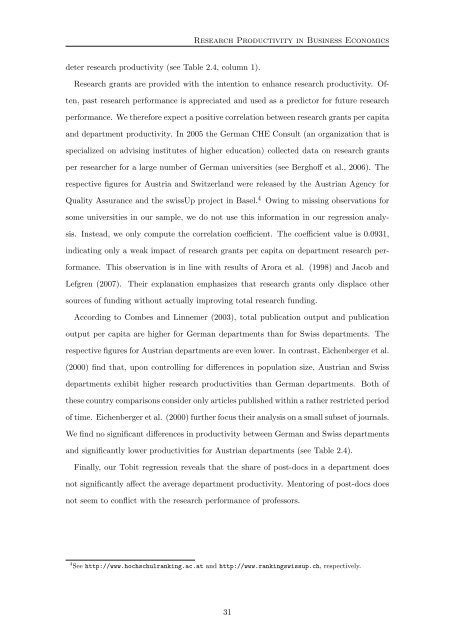Four Essays on University Economics - KOPS - Universität Konstanz
Four Essays on University Economics - KOPS - Universität Konstanz
Four Essays on University Economics - KOPS - Universität Konstanz
Create successful ePaper yourself
Turn your PDF publications into a flip-book with our unique Google optimized e-Paper software.
deter research productivity (see Table 2.4, column 1).<br />
Research Productivity in Business Ec<strong>on</strong>omics<br />
Research grants are provided with the intenti<strong>on</strong> to enhance research productivity. Of-<br />
ten, past research performance is appreciated and used as a predictor for future research<br />
performance. We therefore expect a positive correlati<strong>on</strong> between research grants per capita<br />
and department productivity. In 2005 the German CHE C<strong>on</strong>sult (an organizati<strong>on</strong> that is<br />
specialized <strong>on</strong> advising institutes of higher educati<strong>on</strong>) collected data <strong>on</strong> research grants<br />
per researcher for a large number of German universities (see Berghoff et al., 2006). The<br />
respective figures for Austria and Switzerland were released by the Austrian Agency for<br />
Quality Assurance and the swissUp project in Basel. 4 Owing to missing observati<strong>on</strong>s for<br />
some universities in our sample, we do not use this informati<strong>on</strong> in our regressi<strong>on</strong> analy-<br />
sis. Instead, we <strong>on</strong>ly compute the correlati<strong>on</strong> coefficient. The coefficient value is 0.0931,<br />
indicating <strong>on</strong>ly a weak impact of research grants per capita <strong>on</strong> department research per-<br />
formance. This observati<strong>on</strong> is in line with results of Arora et al. (1998) and Jacob and<br />
Lefgren (2007). Their explanati<strong>on</strong> emphasizes that research grants <strong>on</strong>ly displace other<br />
sources of funding without actually improving total research funding.<br />
According to Combes and Linnemer (2003), total publicati<strong>on</strong> output and publicati<strong>on</strong><br />
output per capita are higher for German departments than for Swiss departments. The<br />
respective figures for Austrian departments are even lower. In c<strong>on</strong>trast, Eichenberger et al.<br />
(2000) find that, up<strong>on</strong> c<strong>on</strong>trolling for differences in populati<strong>on</strong> size, Austrian and Swiss<br />
departments exhibit higher research productivities than German departments. Both of<br />
these country comparis<strong>on</strong>s c<strong>on</strong>sider <strong>on</strong>ly articles published within a rather restricted period<br />
of time. Eichenberger et al. (2000) further focus their analysis <strong>on</strong> a small subset of journals.<br />
We find no significant differences in productivity between German and Swiss departments<br />
and significantly lower productivities for Austrian departments (see Table 2.4).<br />
Finally, our Tobit regressi<strong>on</strong> reveals that the share of post-docs in a department does<br />
not significantly affect the average department productivity. Mentoring of post-docs does<br />
not seem to c<strong>on</strong>flict with the research performance of professors.<br />
4 See http://www.hochschulranking.ac.at and http://www.rankingswissup.ch, respectively.<br />
31

















